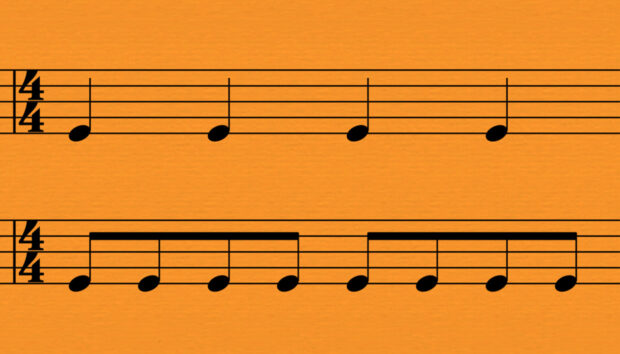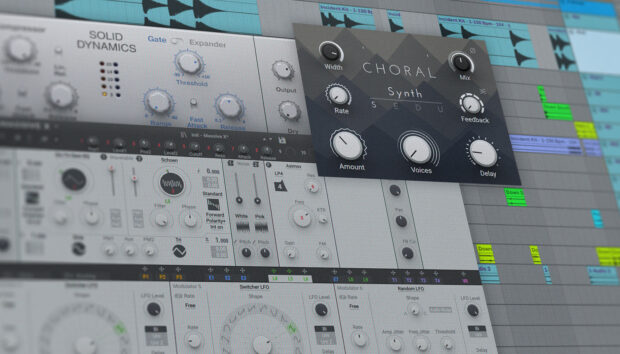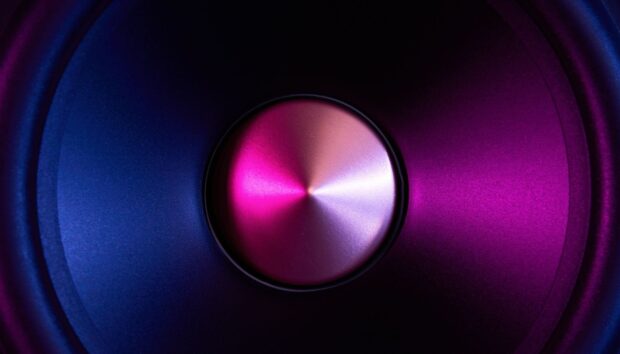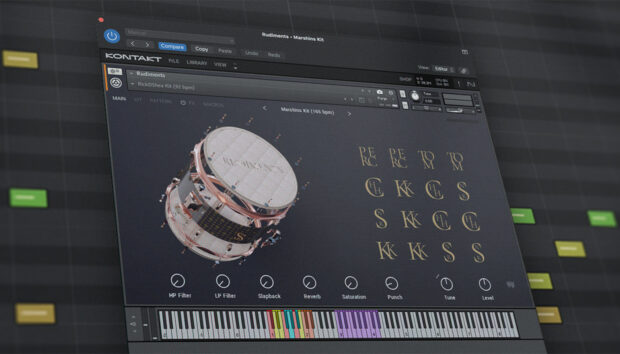
Electro swing is the genre where the raucous revelry of the Roaring Twenties meets modern electronic music production. With plenty of filtered horn stabs, ragtime piano riffs, and infectious rhythms, electro swing music has seen quite the boom in popularity over recent years.
In this tutorial, explore a brief history of the genre and the characteristics that define it. Then, we’ll Charleston our way into a step-by-step tutorial on how to make electro swing music of your own. Whether you’re a seasoned producer or a musical newbie, you’ll be well on your way to creating electro swing tunes that’ll make any dance floor jump and jive with music that can sound like this:
Jump to these sections:
Follow along with Komplete 14, the latest go-to suite for producers, composers, and sound designers, loaded with every tool you could ever need.
What is electro swing music?
Electro swing combines the sounds from yesteryears with the pulsing beats fueling today’s dance floors. It’s where the elegance of swing music meets the vibrant energy of house beats, creating a groove that’s both nostalgic and fresh. Picture a vintage swing band crashing a modern-day house party and you’ve got a pretty good idea of what electro swing sounds like.
To hear it in action, take a listen to this Spotify playlist:
The electro swing genre blossomed in the early 2000s when artists like Parov Stelar and Caravan Palace decided to jazz up old-timey swing with contemporary beats. They pioneered a sound that’s as catchy as it is classy, bridging the gap between the nostalgic charm of the 1920s and today’s dance music energy.
Now that you have a good understanding of the genre, let’s jump into how to successfully pull off that electro swing vibe. Ready to cut a rug?
How to make electro swing music
Let’s explore how to make an electro swing track. We’ll be using many of the plugins and instruments that are included in Komplete 14, the production toolkit that gives you access to dozens of sounds, samples, and effects for any genre.
1. Create a toe-tappin’ rhythm section
Since electro swing music draws inspiration from modern house music, you’ll want to first set the tempo in your DAW to somewhere around 130 BPM. Then, load up a drum instrument and let’s get to laying down a jazzy rhythm. For electro swing drums, I’ve found the best instrument to use is the Abbey Road Vintage Drummer because it uses samples recorded from actual vintage drum kits.
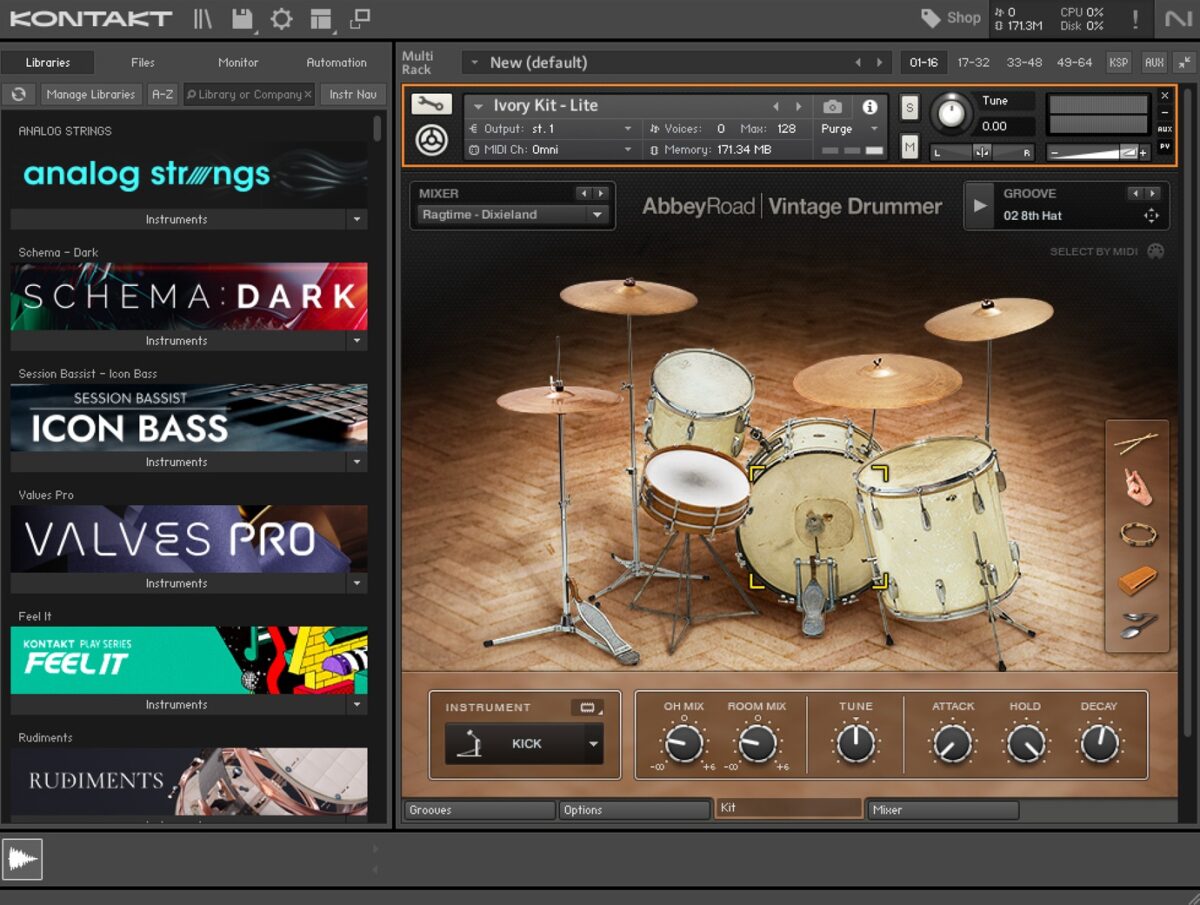
One great feature with the Abbey Road Vintage Drummer is that it comes pre-loaded with tons of drum patterns, or “grooves” that can really shave off time from your production workflow. You can play the included grooves from the top right of the screen and, once you’ve found one you like, simply click and drag it onto your drum track and it’ll put in all the MIDI notes for you. From there, you can tweak the groove to your liking in the piano roll.

Take a listen to this groove I created with the Abbey Road Vintage Drummer:
In order to beef up the rhythm section, you can stack multiple grooves on top of each other. Here’s the original drum groove with an additional pattern for the snares:
And, here’s the combined loop with one more drum groove for the hi-hats:
If you’re programming your own drum grooves, make sure to switch up the velocity of different MIDI notes to give the beat a more lifelike, human feel. And, instead of lining up the MIDI notes right to the beat, nudge some of them around a bit on your timeline to help give it a bit of extra swing.
Now, let’s add in that classic house beat to give it a bit more oomph. For the electronic drum sounds in this demo, I’ll be using Battery 4 with a kit from the Basement Era Expansion called “Jazz Up Kit.”
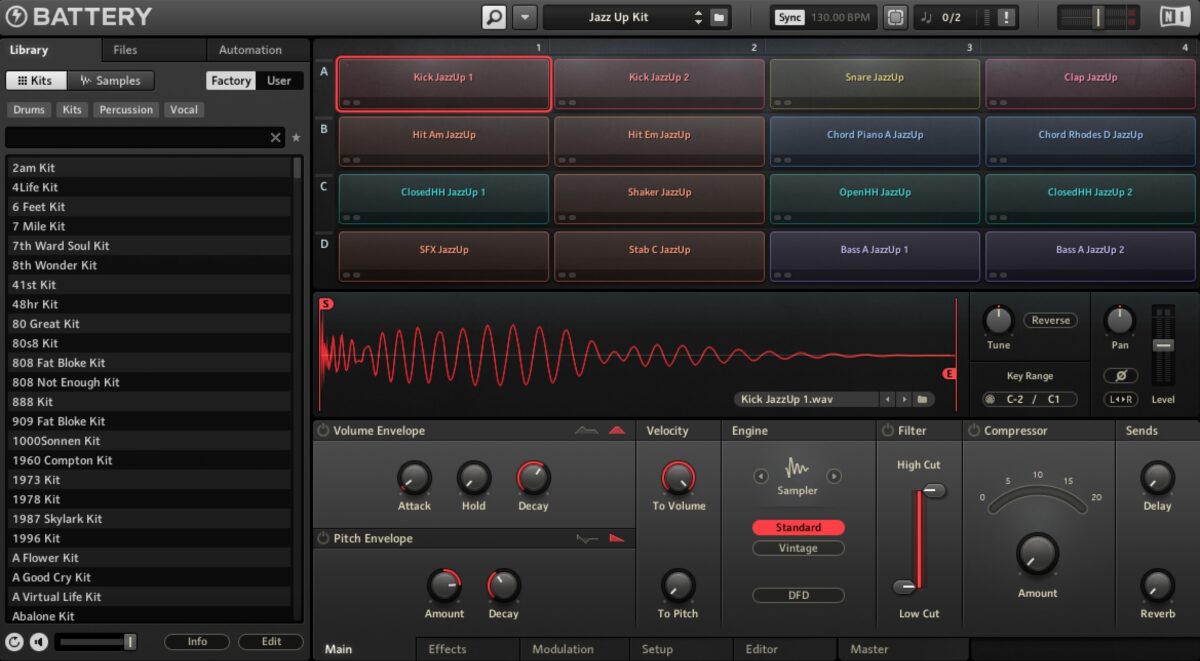
I chose this particular kit because it also includes a few filtered horn stab samples that will be great to toss into the mix. To get the beat below, I laid out a four-on-the-floor kick pattern with a snare on the “2” and “4” as well as some hi-hats on the half-beats. Check it out.
Now, here it is with a couple of those horn stabs thrown in:
Lastly, to help that kick really pack a punch in the subs, I created a new instrument track and loaded up the TRK-01 Kick instrument.
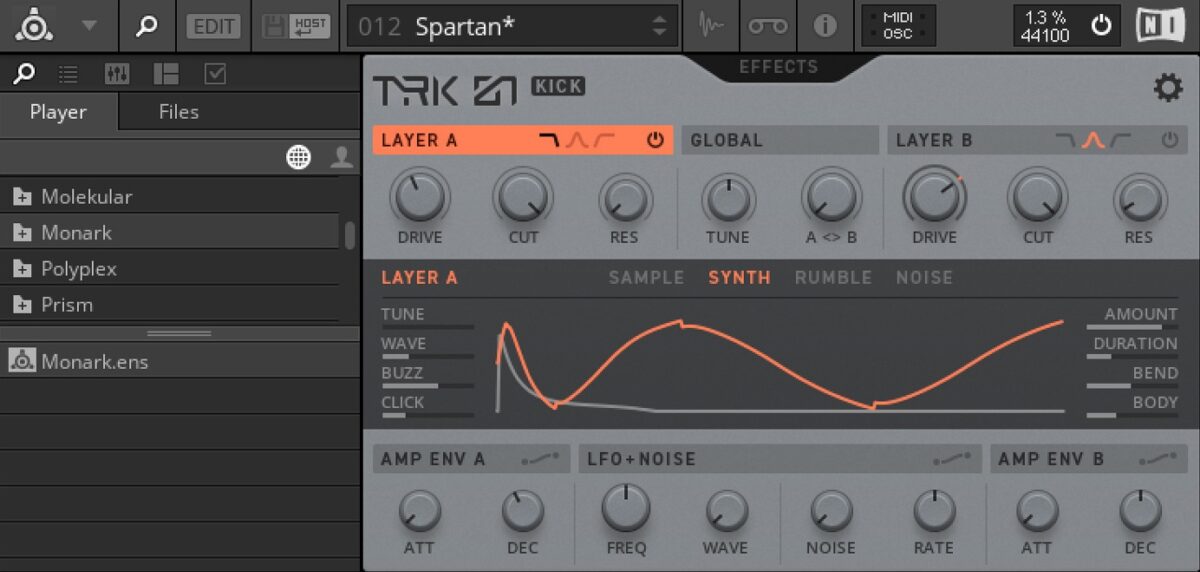
I chose a preset called “Spartan” which has a bit of an electro house sound to it, and then duplicated the four-on-the-floor kick pattern from earlier. Give it a listen.
Now, let’s hear all the percussion played together.
As you can hear, we’re already well on our way to crafting that swingin’ sound!
2. Build a band
Now that we’ve got the rhythm section dialed in, it’s time to build our “live” band. Electro swing music typically always includes plenty of brassy horns and vintage pianos since those were the primary instruments of the swing era. But it’s not uncommon to hear some strummed acoustic guitar and the occasional woodwind trill worked into an electro swing mix.
However you decide to build your band, there’s one really useful tool you’re gonna want to use: iZotope Vinyl. It’s a free plugin, and it works magic to give your instruments that scratchy, vinyl sound. It makes whatever track you put it on sound like it’s being played through an antique phonograph – highly useful for crafting that electro swing vibe.
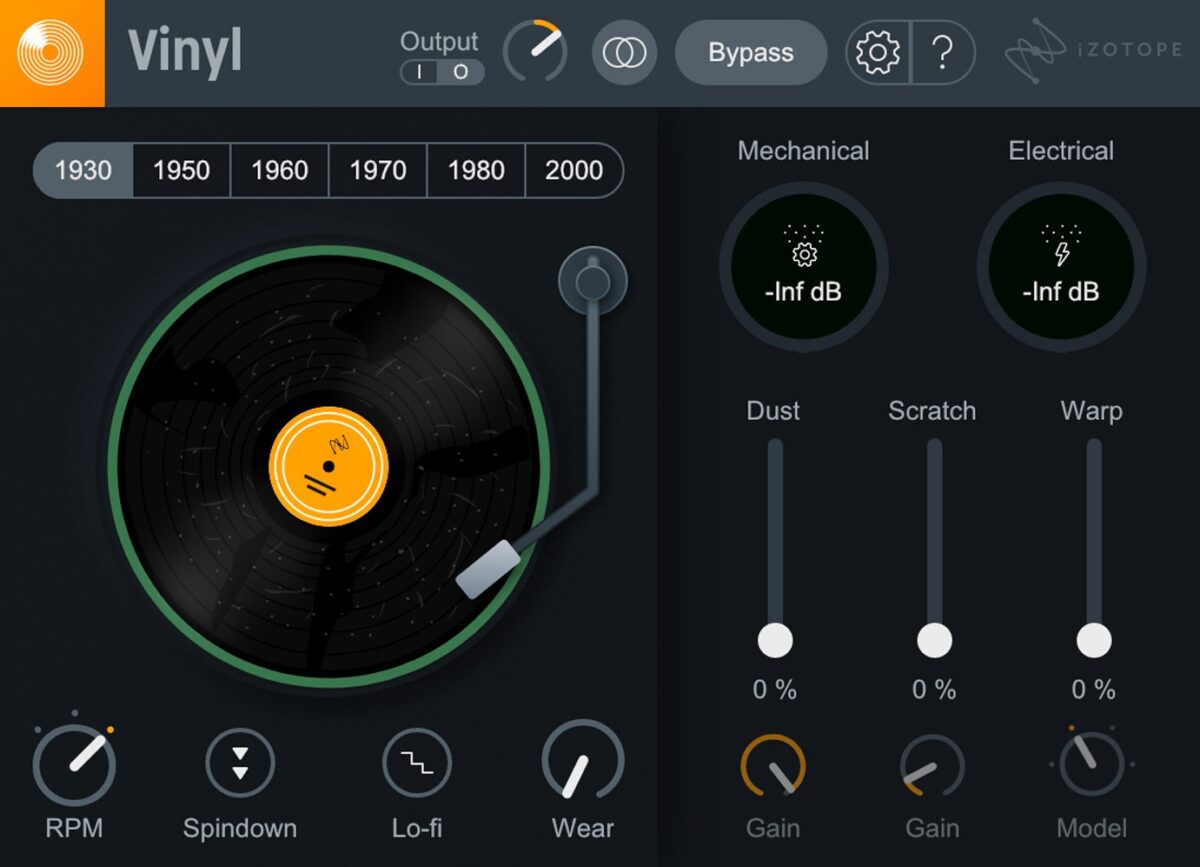
We’ll be using Vinyl on all the instruments of our live band, so you’ll have plenty of chances to hear it in action. But for now let’s start piecing together our instruments.
Horns
For jazzy horns, Session Horns Pro is my go-to Kontakt instrument. It has a really nifty “Voicing Assistant” feature that allows you to quickly and easily generate horn riffs in various styles. For this example, I’ve chosen to go with a pattern preset called “Vintage Harmony” with the settings shown below.

Session Horns Pro makes it so easy to create killer horn samples. I simply played one note on my MIDI keyboard and it churned out this riff:
Now we’ll add iZotope Vinyl to the channel strip, select the 1930 option, and it’ll make it instantly vintage.
Another great tool for producing horn sounds is Valves Pro. This Kontakt instrument is perfect for creating evolving and expressive brass riffs.
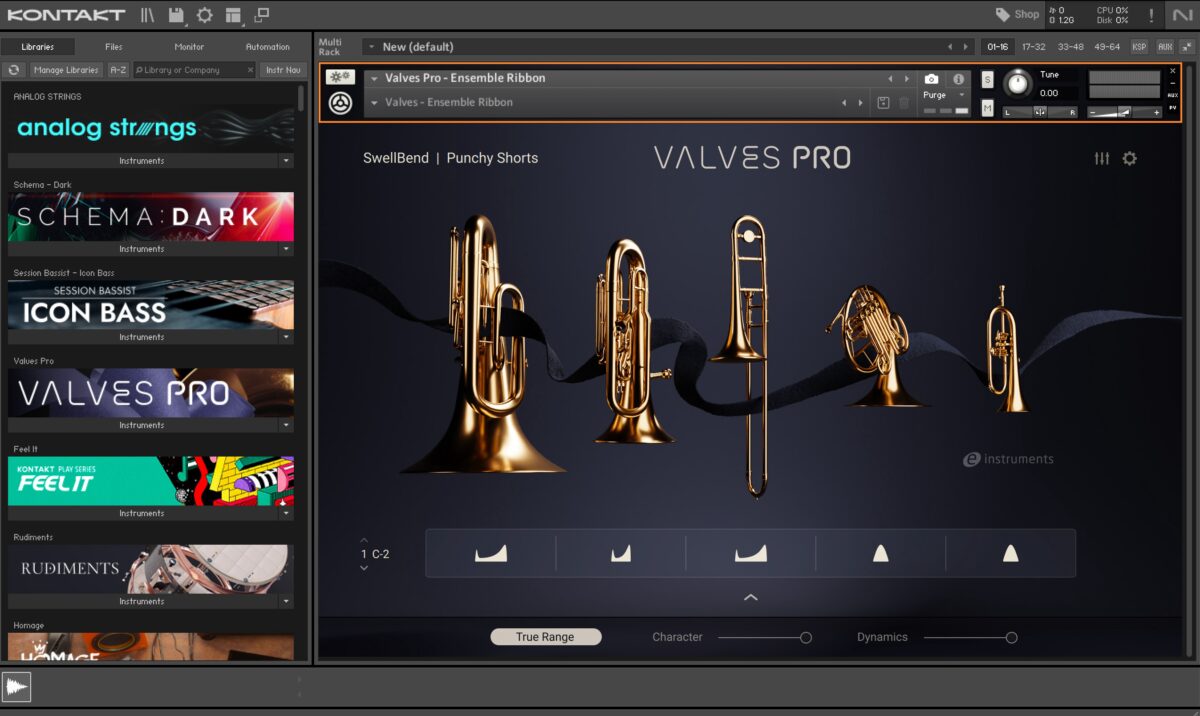
What I love about Valves Pro is that it intelligently assigns your MIDI notes to different brass instruments in a 5-piece ensemble, giving a really realistic sound every time. Take a listen to this super simple loop I created with it:
And now give it a listen through iZotope Vinyl.
Piano
When it comes to that good old fashioned piano sound, nothing quite beats The Gentleman. This Kontakt library samples a classic, upright piano and has just enough zest to bring any electro swing track to life.
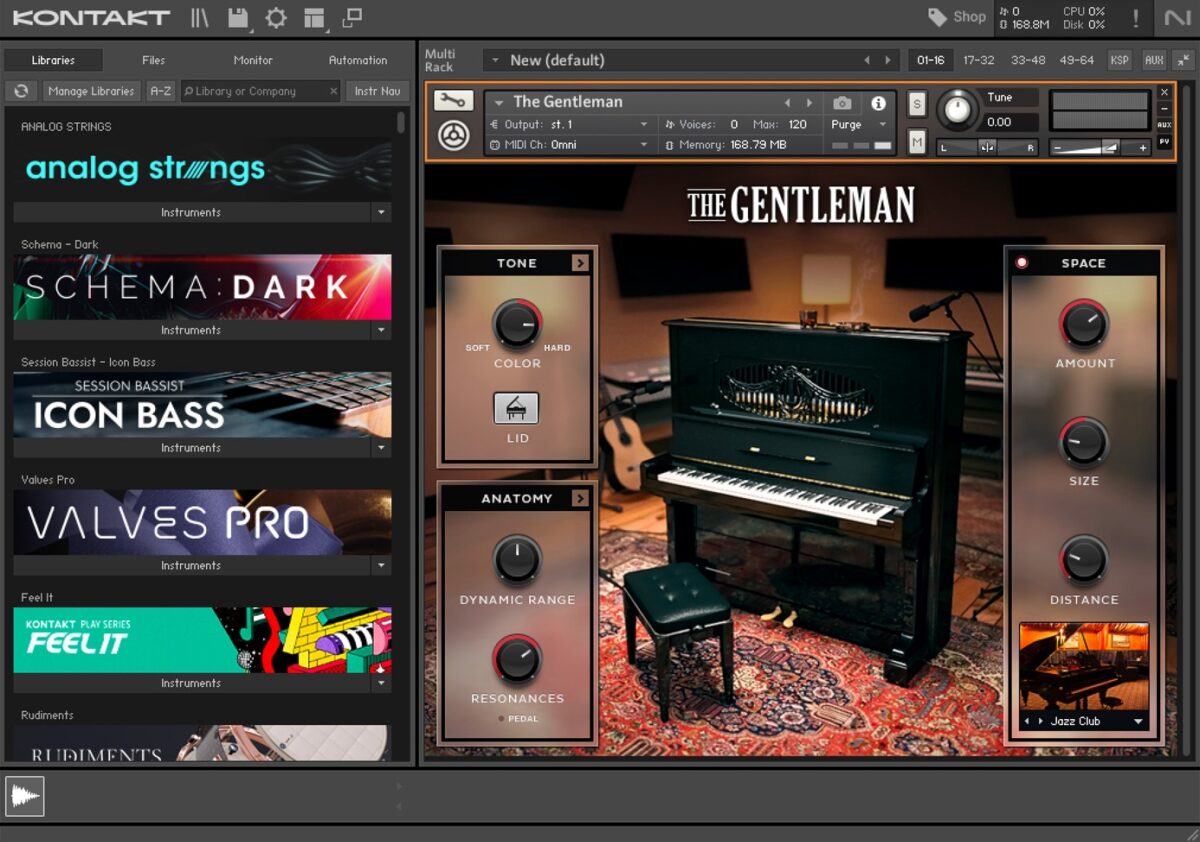
For this example, I cranked up the “Tone” knob up to give the piano a bit of extra bite, and then recorded this jazzy piano riff.
Then following suit, I ran the keys through iZotope Vinyl to get this final loop.
Guitar
To give my track a little extra flavor, I’m going to use Session Guitarist: Strummed Acoustic 2 to generate an energetic guitar loop.
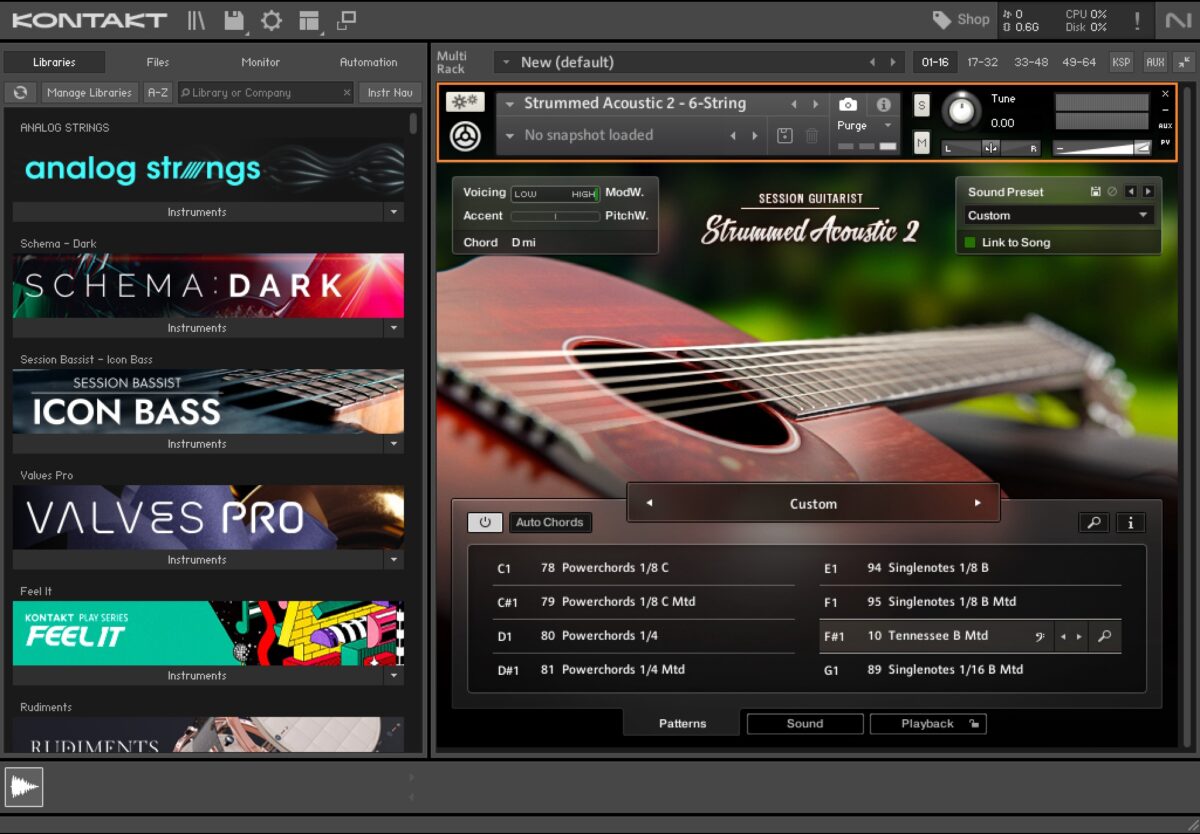
All of the instruments in the Session Guitarist line come loaded with tons of pre-recorded guitar patterns you can use, and you can easily set them to intelligently play along to the key and chords of your song. For this example, I chose a pattern called “Tennessee B,” recorded one MIDI note to trigger the pattern, and Session Guitarist played this for me:
Then, through the Vinyl plugin…
Now, let’s toss all those live instrument riffs into our beat and hear how it all sounds together.
We’ve definitely got a good little ditty going, but it’s still missing out on some of those electro vibes. Let’s give it some synths to help fill up the mix and bring in a dash of modern flair.
3. Add some swingin’ synths
Although synths can bring a touch of the modern to an electro swing track, keep in mind: they don’t have to be overly complex or feature really unique, cutting-edge sound design. So, even though the synthesizers I’ve chosen to use are capable of so much more, we’ll be keeping our synth game pretty simple for this demonstration.
First, we need some sort of bass to help fill in the low end. For this, I’m going to use a preset in the Super 8 synth called “Circuits.”
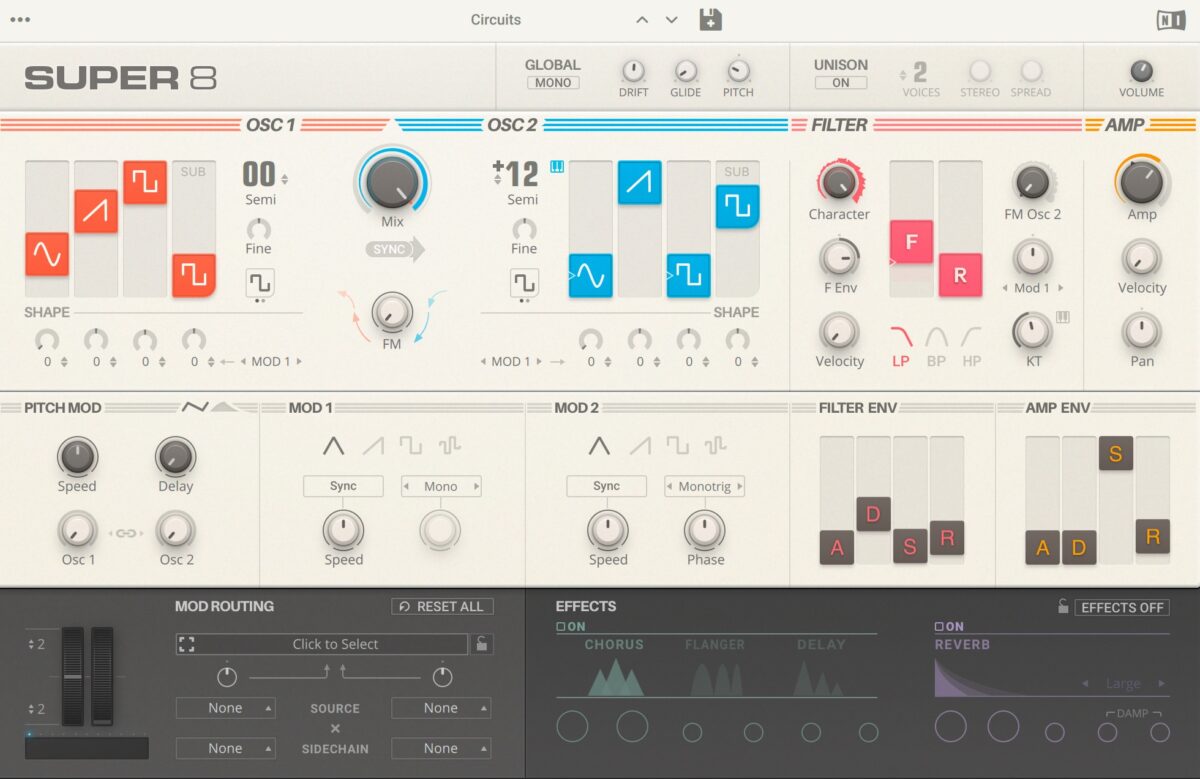
Like I said, we don’t need anything too complicated – just enough to add some contemporary aesthetic to our track. Take a listen to the simple bass loop I created.
Now, let’s make something a bit more crisp to throw into the mix. For that, I’m going to use a preset in Monark called “Chicks.”
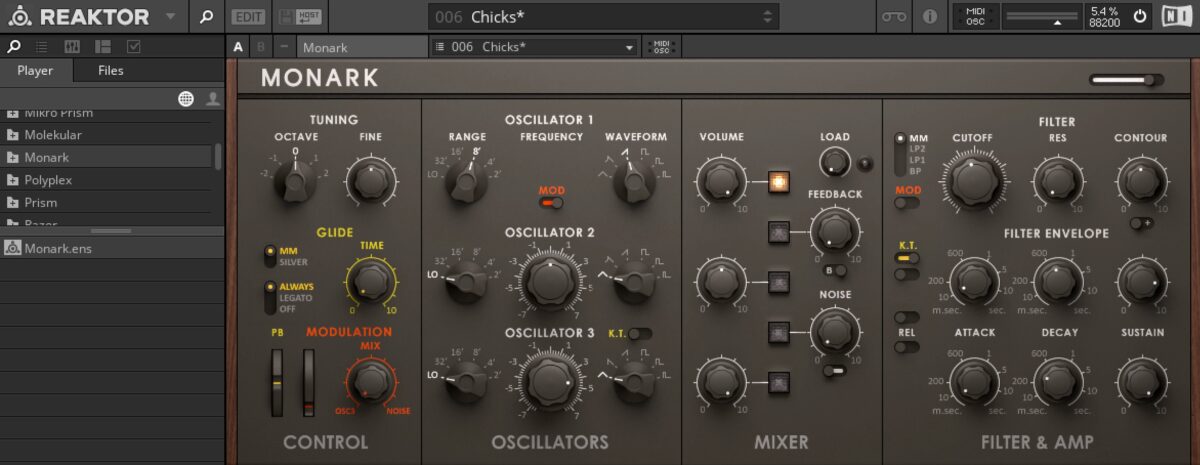
For this particular synth, I’m going to use sidechain compression to give it that “pumping” sound commonly found in house music. To do that, I’ll use Neutron 4 and sidechain it to the TRK-01 kick track.
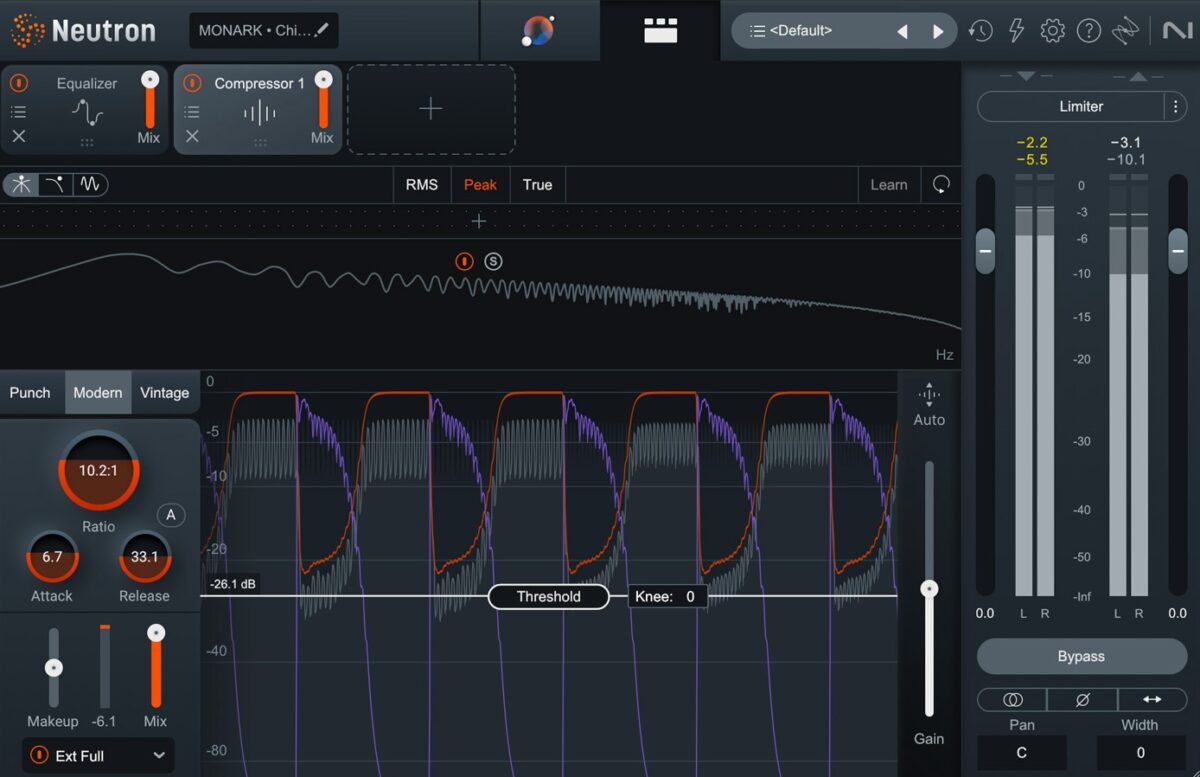
For our last synth, I’m going to go a bit more melodic to help spice up the electronic section of the track. I’ll be using a preset in Massive called “Trick or Treat” from the Global Shake Expansion.
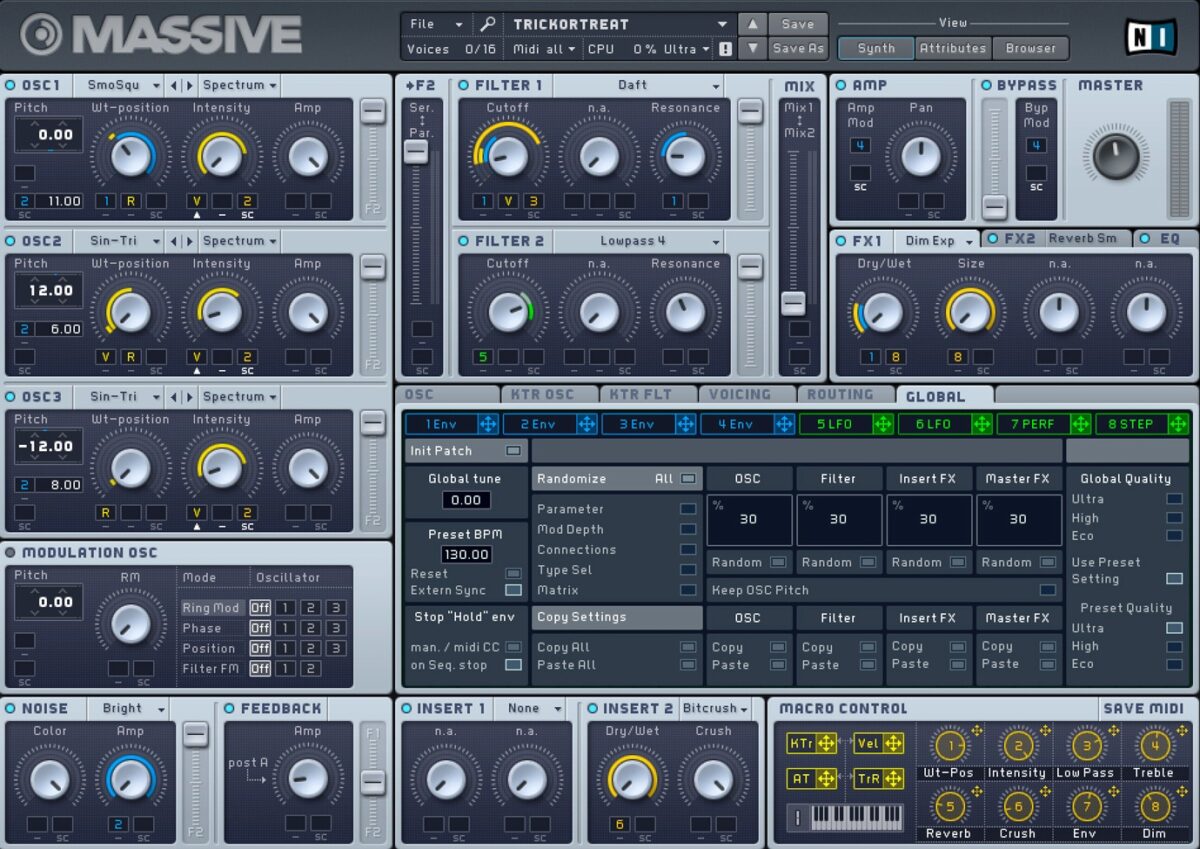
Now that we’ve got our synth elements created, let’s hear them along with the rest of our mix.
Our track already sounds pretty complete! But, just for kicks, we may want to add a few extras to really give it some pizzazz.
4. Toss in some extras
Last on the composition checklist is to add in some extra elements. For example, you may want to throw in some jazzy vocals like these ones I recorded for this demonstration:
If you’re using vocals, don’t forget to run them through the Vinyl plugin. Pro tip: slice up your vocal samples to create little vocal chops like so.
You may also want to add in some risers/falls to help each section transition into the next. For example, the riser below (called “Riser For You”) from the Rhythm Source Expansion could be thrown into your electro swing mix to build up the energy before transitioning to a new section.
Feel free to get creative with the extras you decide to work into your final mix. Once you have all the elements you want to include, it’s time to piece them all together into your final composition.
5. Arrange, mix, and master
When arranging the various elements of your mix, try to build and release some tension between sections of your track in order to keep listeners engaged. That being said, many songs in the electro swing genre can be fairly repetitive, so you don’t have to necessarily aim for some big, grandiose “drop” like you might with other EDM genres.
Once you have an arrangement you’re happy with, you can use tools like Neutron 4 to help with the mixing process and get all your samples and instruments sounding like a good, cohesive mix. Then, go ahead and run the entire mixdown through Ozone 11 (included in Komplete 14) for a touch of mastering magic.
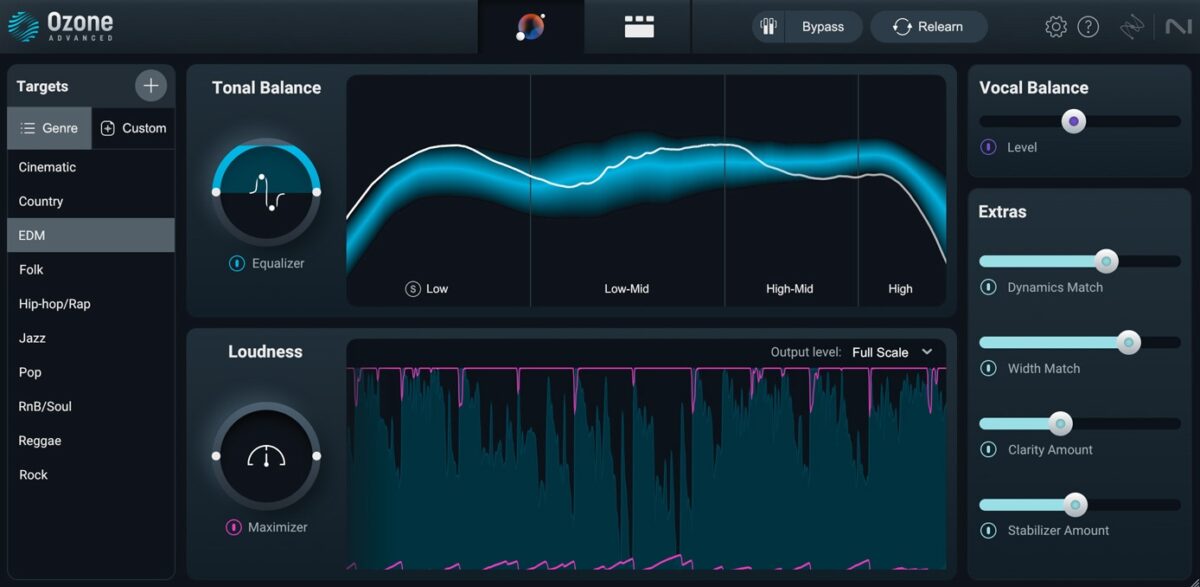
The latest version of Ozone includes several enhancements to the “Master Assistant” and it yields some pretty impressive results. Take a listen to my final electro swing track below after Master Assistant did its thing.
Start producing electro swing
There you have it, folks! With the right tools, blending those swingy, vintage vibes with modern dance elements can be easy and exciting. Like I mentioned above, you can get access to most of the instruments, plugins, and synths in this tutorial by getting Komplete 14.
Start snappin’ out some electro swing music for yourself! You’ll be puttin’ on the ritz in no time.









